Creativity, Bound Flow & The Concept of Shu-Ha-Ri
In Kata
By Deborah Klens-Bigman, Ph.D.
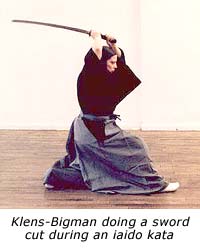 One
of the questions that often comes up with regard to
my studies in iaido (the art of drawing the sword)
and Nihon buyo (Japanese classical dance) is whether
there is any element of creativity involved in these
very traditional art forms which feature highly stylized
timing and movement. Both are based on the study of
kata, usually translated in the West as "form."
However, the English word "form" does not
begin to explain the complexity of what kata actually
is. Kata, especially in non-sport martial arts, are
patterns of movement which embody techniques and stylistic
elements of a particular art form. Some older martial
arts forms consist almost entirely of kata, with little
"freestyle" movement. One
of the questions that often comes up with regard to
my studies in iaido (the art of drawing the sword)
and Nihon buyo (Japanese classical dance) is whether
there is any element of creativity involved in these
very traditional art forms which feature highly stylized
timing and movement. Both are based on the study of
kata, usually translated in the West as "form."
However, the English word "form" does not
begin to explain the complexity of what kata actually
is. Kata, especially in non-sport martial arts, are
patterns of movement which embody techniques and stylistic
elements of a particular art form. Some older martial
arts forms consist almost entirely of kata, with little
"freestyle" movement.
Kata has been a traditional tool for teaching martial
arts in Japan for centuries and is also prevalent
throughout Japanese traditional arts including, but
in no way limited to, flower arranging, tea, traditional
Japanese dance, and the kabuki and noh theaters.
This article is in part entitled "bound flow"
so as to be able to draw on the insights of Rudolph
Laban (1879-1958), a pioneer in movement analysis.
Laban developed a system that could be used, he hoped,
for all observable movement. Eventually, his "Labanotation"
was used extensively for dance and choreography (1).
"Flow" was one of Laban's elements of analysis.
It is defined as motion produced by a single effort,
or impulse to move, but which can be variously bound,
or controlled, depending on its function. Laban felt
that more tightly bound flow is more task-oriented
and is associated with labor. Less "bound,"
or freer flowing movement is associated with emotional
expression, that is, with more creative impulses.
At its most "bound," there is no visible
movement at all.
"Bound flow" refers to movement which
is held in check by certain parameters, for example
ballet or other highly codified choreography. Since
I study both martial arts and Japanese classical dance,
"bound flow" has a great deal of significance
for me. To the untrained eye, both iaido and Japanese
classical dance forms look much more "bound,"
than "flowing," or you might say, more like
work than self-expression.
To be able to discuss creativity and how it relates
to expression of both martial arts and other Japanese
arts, it is useful to examine research in this subject.
The "ura" (or hidden) meaning of my using
"bound flow" in the title of this paper
has to do with the works of psychologist Mihaly Csikszentmihalyi,
whose most recent book, "Creativity" (1996),
provides some theoretical underpinnings for discussion.
"Creativity" examines the achievements
and characteristics of highly creative people, "with
a capital C" -- those who came up with some innovative
technique or strategy that is recognized within a
particular domain of study, and is further recognized
by what the author refers to as "the field",
that is, already recognized experts in a particular
area. This new discovery or approach then changes
the domain of study from that point on. The study
was based on interviews of a spectrum of well known
scientists, business people, artists and writers,
including several Nobel Prize winners.
While there are problems applying this criteria to
indigenous Asian art forms, there are nevertheless
at least some facile similarities that can be suggested
with regard to some koryu (pre-17th century) martial
arts which still exist today.
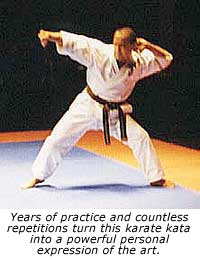 Csikszentmihalyi
notes that "creative with a capital C" individuals
are not contained in vacuums. Without exception, all
of his interview subjects are steeped in their chosen
domain of study, and have spent many hours training
in it. The archetypal founder of a koryu is usually
depicted as a seasoned warrior who spends several
days or weeks in a Shinto shrine or other sacred place,
without food or water, deep in meditation. At the
end of his ordeal, he emerges in possession of a divine
vision of what the new art form should be. He thereafter
spends years refining and perfecting his system. Only
after this period of development is it passed on to
a small group of disciples. These subsequent teachers
add their own insights, some occasionally developing
new styles altogether, others evolving and preserving
the founder's art form through successive generations. Csikszentmihalyi
notes that "creative with a capital C" individuals
are not contained in vacuums. Without exception, all
of his interview subjects are steeped in their chosen
domain of study, and have spent many hours training
in it. The archetypal founder of a koryu is usually
depicted as a seasoned warrior who spends several
days or weeks in a Shinto shrine or other sacred place,
without food or water, deep in meditation. At the
end of his ordeal, he emerges in possession of a divine
vision of what the new art form should be. He thereafter
spends years refining and perfecting his system. Only
after this period of development is it passed on to
a small group of disciples. These subsequent teachers
add their own insights, some occasionally developing
new styles altogether, others evolving and preserving
the founder's art form through successive generations.
In spite of obvious cultural differences, this archetypal
story of a ryuha founder actually fits into Csikszentmihalyi's
definition of domain-changing creative individuals,
and furnishes a basis for considering martial arts
as the product of creativity with a capital C. So
important is the story of the divinely-inspired founder,
many more modern martial art forms have also adapted
this story. In modern media involving popular interpretations
of martial arts, the "inspired founder"
is reincarnated as an inspiring teacher, for example,
Pat Morita's character in the Karate Kid movies, or
even Splinter, the rat-teacher of the Teenage Mutant
Ninja Turtles.
However, this still brings me back to my original
question: how does one determine the way in which
creativity fits in with the performance of martial
arts kata? What does that performance have to do with
flow, bound or otherwise?
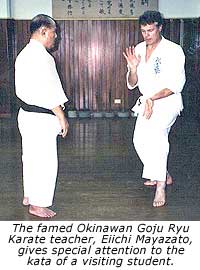 First,
we should look at kata as the building block of training.
While the origins of kata are unknown, its method
of training involves meticulously following a teacher
in the exact movements that make up the kata. Generally
speaking, martial arts kata involve scenaria of attack
and defense, though they are often expanded by arrangement
into longer sequences of attacks and defenses from
the front, back, and both sides. Students endlessly
repeat the movements, over and over, subject to correction
by the teacher and senior students. There is nothing
magical about the endless repetition of kata practice
- it really IS endless repetition. Many more traditional
teachers rarely, if ever, offer explanation for what's
being done, and are unlikely to let a student progress
until certain kata are memorized to their satisfaction,
a process that can take years. First,
we should look at kata as the building block of training.
While the origins of kata are unknown, its method
of training involves meticulously following a teacher
in the exact movements that make up the kata. Generally
speaking, martial arts kata involve scenaria of attack
and defense, though they are often expanded by arrangement
into longer sequences of attacks and defenses from
the front, back, and both sides. Students endlessly
repeat the movements, over and over, subject to correction
by the teacher and senior students. There is nothing
magical about the endless repetition of kata practice
- it really IS endless repetition. Many more traditional
teachers rarely, if ever, offer explanation for what's
being done, and are unlikely to let a student progress
until certain kata are memorized to their satisfaction,
a process that can take years.
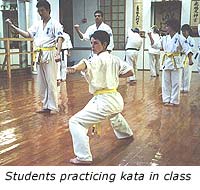 From
the point view of someone not involved in a kata-oriented
tradition, this method of learning seems highly formalized,
codified, rigid, and dull. Many Western scholars writing
about Japanese art forms have expressed their admiration
for the fact that such highly formalized art forms
like kabuki can still be entertaining (though some
writers actually find kabuki performance just as rigid
and non-creative as the training). Personally, however,
I find many traditional Japanese art forms compelling,
theatrical, and very powerful. Given the formal rigidity
of kata, how can this be? From
the point view of someone not involved in a kata-oriented
tradition, this method of learning seems highly formalized,
codified, rigid, and dull. Many Western scholars writing
about Japanese art forms have expressed their admiration
for the fact that such highly formalized art forms
like kabuki can still be entertaining (though some
writers actually find kabuki performance just as rigid
and non-creative as the training). Personally, however,
I find many traditional Japanese art forms compelling,
theatrical, and very powerful. Given the formal rigidity
of kata, how can this be?
To consider some of the deeper functions and meanings
of kata, I would like to rely on my experience in
iaido, the art of drawing the sword. As in kabuki
and Japanese classical dance, training for this particular
martial art is primarily through kata, since it is
difficult to spar with a sword. The high level of
respect accorded to swords in Japan as well as the
extremely dangerous nature of the weapon and techniques
being learned make the formality of kata for iaido
a compelling necessity. Iaido kata make up not only
the learning process of the art form but the content
of it as well.
In this case kata practice teaches technique, strategy,
and perhaps, after many years of practice, the underlying
principles of iaido. By "underlying principles,"
I mean the logic of the movement - why the hardworking
and divinely inspired developers of the ryuha (school
or tradition of teaching) decided to do it THIS way
and not THAT way.
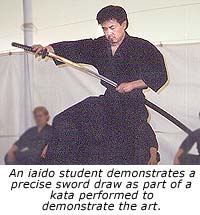 On
the face of it, one might assume that the study of
iaido would contribute hugely to an argument for rigidity
and lack of creativity. Fuel for this argument can
be readily obtained in the way many people, both in
Japan and the US, currently practice the art form.
Emphasis is relentlessly placed on correcting the
smallest details of kata, and larger principles seem
to be devalued. However, this is not really the case.
After many years of imitating teachers and senior
students, practitioners are eventually able to move
beyond, or through, technique. All the technical aspects
of the kata are still intact and can be seen by observers,
but the way in which the kata is performed becomes
highly individualized. In our Dojo, we refer to this
as "owning the kata." Iaido then goes from
being "about as much fun as watching paint dry,"
as one observer of junior students put it, to an art
form that is both beautiful and somewhat daring in
its execution (Prough 1996). On
the face of it, one might assume that the study of
iaido would contribute hugely to an argument for rigidity
and lack of creativity. Fuel for this argument can
be readily obtained in the way many people, both in
Japan and the US, currently practice the art form.
Emphasis is relentlessly placed on correcting the
smallest details of kata, and larger principles seem
to be devalued. However, this is not really the case.
After many years of imitating teachers and senior
students, practitioners are eventually able to move
beyond, or through, technique. All the technical aspects
of the kata are still intact and can be seen by observers,
but the way in which the kata is performed becomes
highly individualized. In our Dojo, we refer to this
as "owning the kata." Iaido then goes from
being "about as much fun as watching paint dry,"
as one observer of junior students put it, to an art
form that is both beautiful and somewhat daring in
its execution (Prough 1996).
The Japanese explanation for this progression is
"shu-ha-ri." "Shu" means conservative,
sometimes interpreted as "tradition" --
the period in which one learns all the kata pertaining
to the style by heart. "Ha" means "break,"
and is often referred to as "breaking with tradition,"
but I think this is incorrect. Instead, I think "ha"
means "breaking through the technique" by
actually evolving through it rather than discarding
it. "Ri" means "freedom": a state
in which the techniques become so embedded in the
practitioner that they can be expressed in free-flowing
movement. In other words, the beginner is totally
immersed in Laban's workman-like bound flow process
of learning kata, and eventually moves beyond it to
the much less bound flow process of the expert practitioner,
ever closer to the creative flow experience.
Shu-ha-ri takes a lifetime. My teacher, Yoshiteru
Otani (1998), says each phase takes 10 to 15 years
to complete. So, with diligent practice, it takes
20 to 30 years to reach Ri, and then, only with some
luck. Many practitioners give up out of boredom or
frustration before reaching this state, and some,
though they practice and practice, never achieve it.
On the other hand, technique learned through kata
moving through the process of shu-ha-ri can potentially
become a springboard for creativity.
In this way, iaido training is similar to both Japanese
classical dance and kabuki. One dancer with whom I
recently spoke suggested that kata is like the Tardis,
the phone booth/time travel machine of Dr. Who (I
would have suggested Valantino's tent in Son of the
Sheik) - it looks small and confined on the outside,
but it's endlessly large on the inside (Moss 1998
n.p.).
Therefore, when someone tells me that he was bored
at a traditional (that is, a non-sport) martial art
demonstration, I tell them with some confidence "what
you saw was probably not very good," or, else
"They were probably beginners;" that is,
the practitioners were stuck in shu, a state that
has interest for them, but for no one else. In the
hands of a master, for example Shibata Kanjuro in
kyudo, Nakayama Hakudo in iaido, or even my own teacher,
Otani Yoshiteru, these very formalized art forms take
on life and expressiveness.
Why is kata uniquely suited to these art forms? Why
don't people learn as well from technique drills,
or from videotape? An argument can be made that kata
practice as a teaching method became popular because
it acted as a physical encyclopedia, preserving the
form from the teachers' to the students' bodies over
generations. With the advent of videotape and CD-ROM
disks, its use seems less important now that these
forms of recording or reproducing movement are available.
But this is not the case. In fact, an experienced
practitioner can easily pick out the student who has
studied from videotape without benefit of a master
teacher (2). In contrast, kata practice, with a live
teacher, provides a progressive form of "deep
learning" which does not seem to be attainable
in any other way. Endless repetition in striving to
replicate exactly what the teacher is doing, in all
its variations, deeply imbeds not only that technique
of the art form being learned, but also builds the
meaning of the movement being done.
The martial arts student is learning not just the
content of the curriculum of the style but also the
tactics, techniques, and hopefully the underlying
principles that make up the particular style of martial
art form he or she is studying. Shu-ha-ri is often
described as circular, but I think "spiral"
might be more accurate: in the beginning, the student's
movements are awkward and express nothing so much
as his physical self with what he has initially brought
in terms of experience to the dojo, to the stage where
he becomes expert at imitating his teachers and seniors,
to the point where he can once again express himself
through this new, codified movement. In terms of the
spiral, the student is crossing that point where she
began, but unlike the circle, she crosses it at a
higher level. (3) In the Laban sense, though still
bound, the flow of movement becomes freer and more
expressive, approaching the Csikszentmihalyi definition
of creative flow.
There is simply no way drilling in abstract techniques
and sparring for martial arts to create a similar
result, though this type of training is considered
"more efficient." We are already seeing
this in highly sportified forms, where tournament
results take precedence over any form of deep learning.
The result is legions of students, which is to say
quantity, who really have no idea what they're actually
doing. This may mean income for the teacher for the
present, and the loss of the art form further down
the road, as people trained in this method lack the
depth imparted by kata training and become bored as
a result.
For us mere mortals, Csikszentmihalyi concludes "Creativity,"
by suggesting ways for us to become more creative
in our daily lives. He notes that individuals who
make time for creative activity, learn to focus, strive
to stay disciplined and find a direction to channel
focused energy can enrich themselves by being more
creative. Dedicated martial artists (or artists of
any kind) fit this definition very well.
A few extraordinary and innovative martial artists
have founded or modernized their arts -- Kano Jigoro
(judo), Ueshiba Morihei (aikido), Nakayama Hakudo
(iaido) and Funakoshi Gichin (karate-do). Each could
be said to have changed his area of study for posterity,
and impressed the field, that is, leading teachers,
if not in their lifetimes, then certainly afterward.
Each was first "deeply steeped in their discipline(s)"
of study before they took a unique approach to a situation:
how to preserve and perpetuate martial arts in a rapidly
modernizing and increasingly forgetful world.
Notes
1- Laban divided movement into four elements: weight,
space, time and flow, through which he felt virtually
every movement could be recorded on paper. Flow, it
should be noted, is affiliated with, but separate
from, rhythm (beats distinguished by an interval of
rest). Pioneering anthropologist Franz Boaz employed
a ballerina trained in the method to record movements
of work and play of Native American tribes of the
Pacific Northwest, though one of the problems with
the method is interpretive; i.e. different cultures
don't necessarily assign the same values to the elements
Laban uses for analysis. Labanotation was also expanded
to recording everyday movement and folk dances of
peoples around the world. Laban's system of notation
was (and still is) used mostly to record dance and
choreography.
2- Video tape learning is problematic at best. For
one thing, the practitioners are seen in miniature
and subtleties of movement cannot be recorded by the
speed of the camera. The student who uses tape is
also often at a loss when the practitioner turns away
from the camera if other angles are not seen. Another
problem is the tape is exactly the same, and any depth
the living practitioner may have is flattened out.
Movements and their origin are easily misinterpreted
or missed altogether. Perhaps most importantly, the
life span of videos or even CD-ROM are limited; videos
by the instability of the recording medium itself,
and CD's by the constantly changing technology which
makes accessibility a problem after a short span of
time. Therefore, individuals who feel they are able
to master a set of movements in part because they
"have it on tap" are making a mistake on
a number of levels.
3-I am indebted to Margaret Thompson Drewal (1992)
for the concept of the spiral, rather than a circle,
in describing repetition of actions over time.
Bibliography
Csikszentmiahlyi, Mihaly1996: Creativity: Flow and
the psychology of discovery and invention (New York:
Harper Perennial).
Drewal, Margaret Thompson1992: Yoruba Ritual: Performers,
Play, Agency (Bloomington and Indianapolis: Indiana
University Press).
Friday, Karl1998: Personal communication
Laban, Rudolf1988: The Mastery of Movement (Plymouth,
UK: Northcote House).
Moss, Helen E.1998: Personal communication
Otani Yoshiteru1998: Interview with the author.
Prough, John1996: The Iaido Newsletter (Toronto:
Sei do kai Pub.).
Let
Us Know Your Comments & Opinions On This Article

About The Author:
Deborah Klens-Bigman is Manager and Associate Instructor
of iaido at New York Budokai in New York City. She
has also studied, to varying extents, kendo, jodo
(short staff), kyudo (archery) and naginata (halberd).
She received her Ph.D in 1995 from New York University's
Department of Performance Studies where she wrote
her dissertation on Japanese classical dance (Nihon
Buyo). and she continues to study Nihon Buyo with
Fujima Nishiki at the Ichifuji-kai Dance Association.
Her article on the application of performance theory
to Japanese martial arts appeared in the Journal of
Asian Martial Arts in the summer of 1999. She is married
to artist Vernon Bigman.

back
to top
home
| about
us | magazine
| learning
| connections
| estore
|